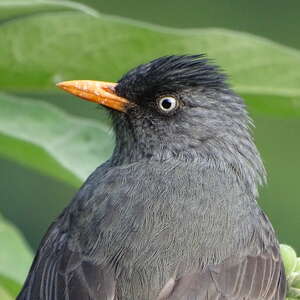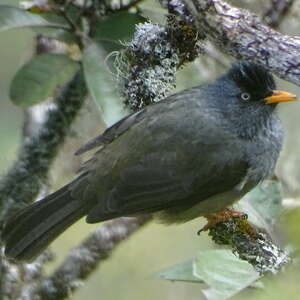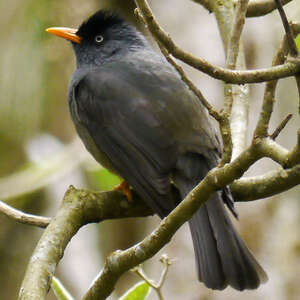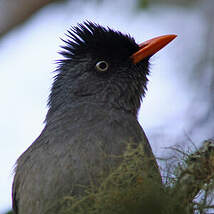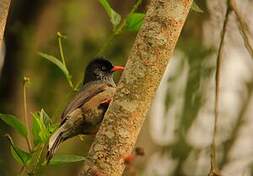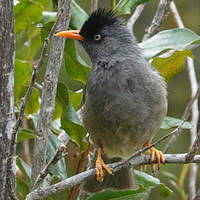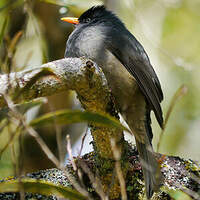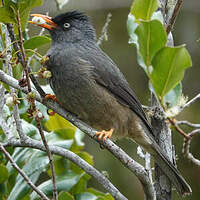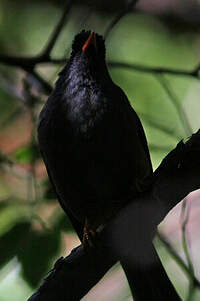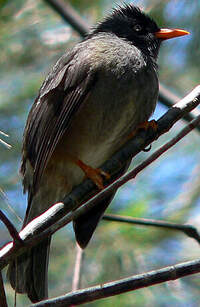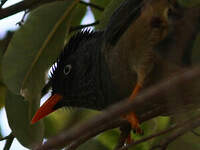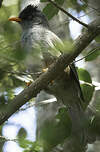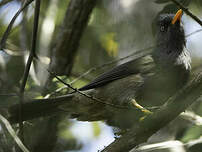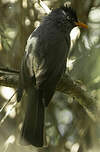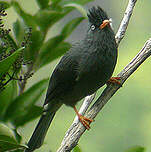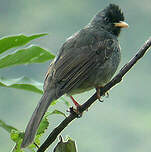Reunion Bulbul
Hypsipetes borbonicus - Bulbul de Bourbon
Identification
The Reunion Bulbul, as its name suggests, is endemic to the island of Réunion. Locals refer to it as Merle pays (Merl pei in Creole). It is not to be confused with the Eurasian Blackbird (Pycnonotus jocosus), which is also present on Réunion. Quite similar to other bulbuls in the Madagascar region and still more to the Mauritius Bulbul (Hypsipetes olivaceus), it is more olive-green and is the only one with white irises. There is no sexual dimorphism in this species. The female only has slightly smaller measurements than the male. They all have a common crown with black and shaggy feathers. The feathers on the head become grey ash until the back of the neck, the sides, the throat and chest. The lores remain well black like the crown feathers. The mantle is also grey ash but a bit lighter, with slightly darker streaks. The back, the rump and the stomach are dark olive-grey, some feathers on the lower belly are dirty white. The tail and wing feathers are dark grey-brown with slight black edges. The beak and feet are orange. Juveniles differ from adults in the intensity of the colours, which are more dull and pale. The primaries and secondaries are a rust colour.
Subspecific information monotypic species
Foreign names
- Bulbul de Bourbon,
- Bulbul de Reunión,
- bulbul-da-reunião,
- Réunion-Rotschnabelbülbül,
- réunioni bülbül,
- Réunionbuulbuul,
- Bulbul di Reunion,
- réunionbulbyl,
- Reunionbylbyl,
- bylbyl réunionský,
- bulbulčík réunionský,
- Réunionbulbul,
- reunioninbulbuli,
- bulbul fumat de l'illa de la Reunió,
- szczeciak reunioński,
- Маскаренский восточный бюльбюль,
- レユニオンヒヨドリ,
- 绿短脚鹎,
- 留尼旺島短腳鵯,
Voice song and cries
Habitat
The Reunion Bulbul is a strictly forest bird. It remains, however, absent from forested areas beyond 1,800-2,000 m.
Behaviour character trait
The Reunion Bulbul moves in pairs or small groups of up to 10 individuals if the food concentration is high.
It is a very quiet and shy bird. The only moments when it can be observed are when it jumps from branch to branch on the side of trails or just after being disturbed. It prefers to stay in the heart of the forest, which provides its protection. It feeds on the high and medium branches in search of food and rarely comes down to the ground, except to find fruits of an invasive species of ginger (Hedychium gardnerianum). The Reunion Bulbul can fly for quite a while before settling on the treetop, a place it loves to sing from.Dietfeeding habits
The Reunion Bulbul mainly feeds on endemic fruits and nectar from flowers that it takes directly from the trees. The fruits of the Change-écorce (Aphloia theiformis) seem to be the most abundantly consumed, in addition to the Bois de fer bâtard (Sideroxylon borbonicum) and other species of the island. It may also consume insects that it clumsily catches while flying.
Reproduction nesting
The nesting of the Reunion Bulbul is very poorly known due to the species' great discretion. The female lays 2-3 pinkish white eggs speckled with gray and dark red in a roughly cup-shaped nest in the middle of a fork during the Austral summer (July to December). The young are fed by the parents for two months, mainly with insects and larvae.
Geographic range
Threats - protection
IUCN conservation status
concern
in the Wild
threatened
evaluated
The Reunion Bulbul was part of the hunting game until 1988. The capture using glue was also very common to be served as a dish or as a caged bird. Finally, it was another victim of deforestation. All these reasons led to a dramatic drop in its populations, to the point where the survival of the species was uncertain. It has been fully protected by ministerial decree since 1989, which has stabilized its population. Unfortunately, cases of poaching have not disappeared everywhere. In 2005, its population was estimated at 41,000 individuals.
Sources of information
- IOC World Bird List (v14.1), Gill, F and D Donsker (Eds). 2024-04-18.
- The Birds of Africa Vol VIII : The Malagasy Region, Safford R. et Hawkins F.
- Oiseaux des iles de l'océan Indien, Langrand Olivier, ian Sinclair
- BirdLife International, BirdLife International
- Société d'Etudes Ornithologiques de la Réunion ,
Other sources of interest
 Specification sheet created on
25/07/2023 by Nathalie Santa Maria
Specification sheet created on
25/07/2023 by Nathalie Santa MariaTranslation by AI Oiseaux.net
published: 05-01-2016 - Updated: 06-01-2016
© 1996-2024 Oiseaux.net
- Accipitriformes
- Aegotheliformes
- Anseriformes
- Apodiformes
- Apterygiformes
- Bucerotiformes
- Caprimulgiformes
- Cariamiformes
- Casuariiformes
- Charadriiformes
- Ciconiiformes
- Coliiformes
- Columbiformes
- Coraciiformes
- Cuculiformes
- Eurypygiformes
- Falconiformes
- Galliformes
- Gaviiformes
- Gruiformes
- Leptosomiformes
- Mesitornithiformes
- Musophagiformes
- Nyctibiiformes
- Opisthocomiformes
- Otidiformes
- Passeriformes
- Pelecaniformes
- Phaethontiformes
- Phoenicopteriformes
- Piciformes
- Podargiformes
- Podicipediformes
- Procellariiformes
- Psittaciformes
- Pterocliformes
- Rheiformes
- Sphenisciformes
- Steatornithiformes
- Strigiformes
- Struthioniformes
- Suliformes
- Tinamiformes
- Trogoniformes

